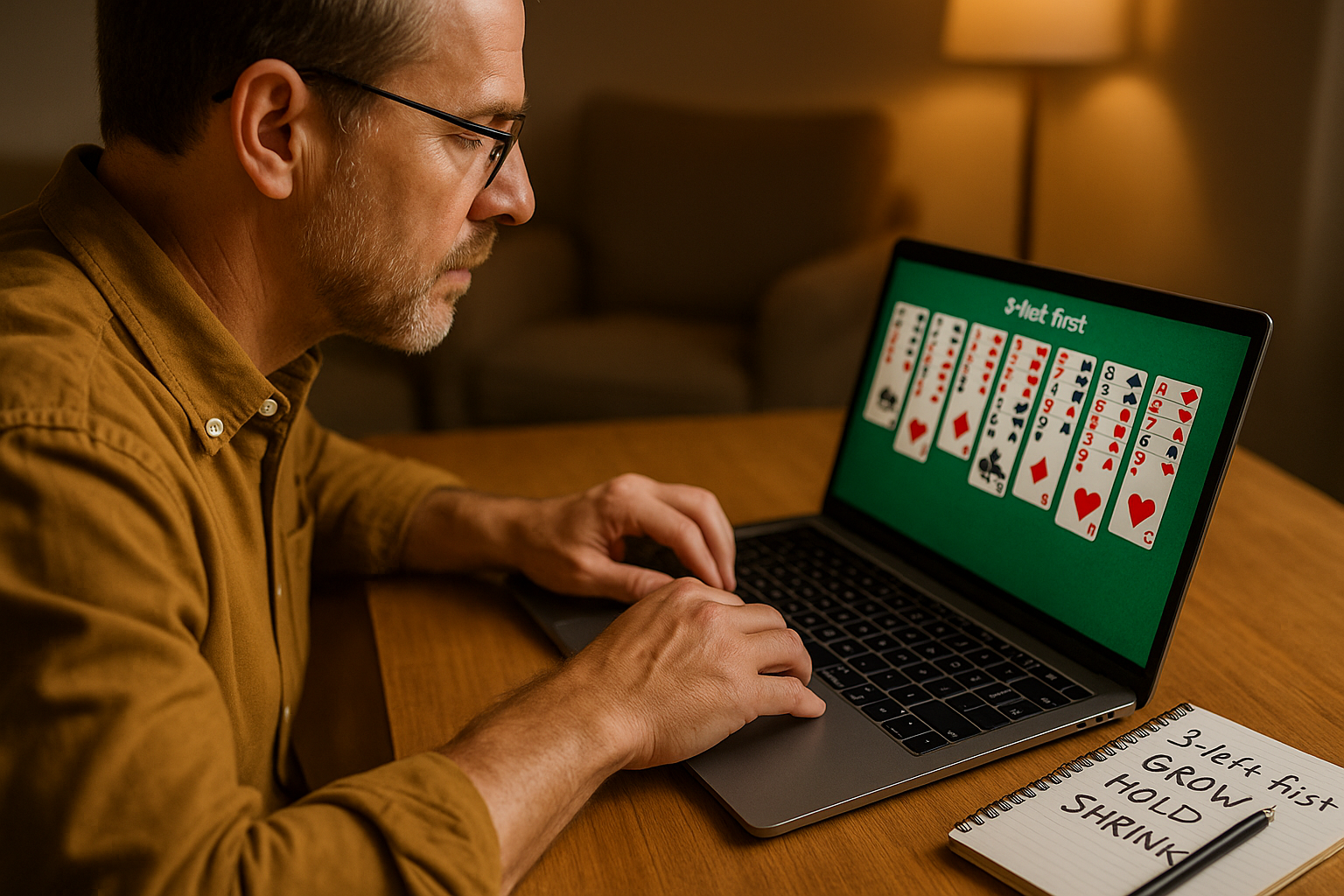Accordion Decision Speed: From Recognition to Intuition
The timer ticks. A 3‑left window blinks open for half a second; you take it without hesitation and the row collapses in a clean cascade. No overthinking. No second‑guessing. That feeling—calm speed—can be trained.
What would happen if your scan order ran on autopilot? If your hands moved faster but your choices stayed clean? How many close games would flip if you shaved just two seconds off each fork? In this final part, you’ll wire recognition into repeatable speed with three short drills, tempo rules, and a lean set of metrics you can track right inside a quick session on Solitairen.
Why Speed Matters (and where it doesn’t)
Speed is not about more clicks; it’s about reducing hesitation on the highest‑value decisions:
-
Choosing 3‑left over 1‑left when both exist.
-
Preserving a dual‑trigger instead of cashing a “pretty” merge.
-
Sequencing moves so one merge unlocks two more.
Ask yourself:
-
Do you re‑scan the same five piles because you don’t trust your first read?
-
Are your fastest moves also your highest EV ones—or just the most obvious?
-
How often does a rushed 1‑left kill the 3‑left you wanted?
-
When the board stalls, do you have a pre‑planned tempo reset, or do you tilt?
The Drill Toolkit (15 minutes total)
Drill 1 — 60‑Second Snap‑Scan (warm‑up)
Purpose: Automate “3‑left first” and dual‑trigger awareness.
Setup: Open Solitairen. Set a 60‑second timer.
Run:
-
Freeze your mouse for the first 5 seconds of each deal.
-
Silently call out: “3‑left?” → “Dual‑trigger?” → “1‑left?”
-
Only then make the move. Repeat through fresh deals for one minute.
Target: ≥10 correct first moves with zero lost 3‑lefts in the minute.
Drill 2 — Chain Builder Sprints (core)
Purpose: Increase cascade frequency without accuracy loss.
Setup: Timer to 3 minutes.
Run:
-
Play normally but label each move in your head as Grow / Hold / Shrink (from Part 2).
-
Take no back‑to‑back Shrinks.
-
If two options tie, choose the one that positions a high‑leverage rank (A/Q/K) nearer to action.
Target: Average Chain Max ≥ 6 while keeping Shrink rate ≤ 25% of moves.
Drill 3 — Tempo Ladder (finisher)
Purpose: Practice rhythm shifts—fast when safe, slow when pivotal.
Setup: Three rounds back‑to‑back.
-
Round A (90 sec): Fast — insta‑play all obvious 3‑lefts.
-
Round B (90 sec): Deliberate — pause 2 seconds before any 1‑left.
-
Round C (90 sec): Hybrid — fast until ≤16 piles remain, then deliberate.
Target: Hybrid round should produce the lowest Compression Index (CI) of the three.
If‑Then Tempo Rules (make speed safe)
-
IF a 1‑left and 3‑left are both legal, THEN simulate the 1‑left in your head and only take it if a 3‑left still survives after compression.
-
IF you’ve taken two Holds in a row, THEN scan five piles left and force a Grow or stop the game and reset (drift is costly).
-
IF you see a dual‑trigger, THEN protect it for one move cycle unless the alternative creates an immediate chain ≥3.
-
IF your last move was a Shrink, THEN your next move cannot be a Shrink.
Tape these next to your screen for the first week. They turn recognition into instinct.
Sabermetrics for Speed (simple, actionable)
Add these to your sheet (keep earlier metrics from Parts 1–2):
-
APM (Actions per Minute): moves ÷ minutes (track per drill).
-
First‑Move Accuracy (FMA): percentage of deals where your first move was 3‑left or created a dual‑trigger.
-
Shrink Rate (SR): Shrinks ÷ total moves.
-
Chain Max (CM): longest cascade per game.
-
CI (Compression Index): piles remaining when you stop (lower is better).
Synthetic example (format only—replace with your data):
| Session | APM | FMA % | SR % | CM (avg) | CI (avg) |
|---|---|---|---|---|---|
| Baseline | 21.4 | 62 | 34 | 5.2 | 12.8 |
| Week 1 (drills) | 23.9 | 74 | 27 | 6.4 | 11.3 |
| Week 2 (hybrid) | 24.6 | 79 | 24 | 6.9 | 10.7 |
How to read it: speed goes up, but accuracy (FMA) rises and Shrink Rate falls—proof that tempo is controlled, not reckless.
Transparent Methodology & Workflow
-
Constraints: Standard Accordion rules, sessions of 10–12 games, log every game.
-
Cadence: 1 minute Snap‑Scan → 3 minutes Chain Sprints → 4.5 minutes Tempo Ladder → 1.5 minutes logging/review.
-
Analysis: Use a 7‑game moving average for CI and FMA. Change one rule per week (e.g., “no back‑to‑back Shrinks”).
-
Quality control: If APM rises while FMA drops for two sessions, dial the tempo down one notch.
Common Speed Leaks (and quick fixes)
-
Happy clicks: Two quick 1‑lefts that erase a 3‑left. Fix: say “3‑left first” before every 1‑left.
-
Endless rescans: Staring at the same window. Fix: the Grow‑Hold‑Shrink label forces a decision.
-
Late‑game panic: Clicking to “do something.” Fix: deploy Hybrid tempo—fast to 16 piles, slow thereafter.
-
Over‑foundationing in other variants: Habit crossover. Fix: remind yourself: no foundations here—options are the currency.
If you like to play solitaire online free with minimal friction, keep Solitairen pinned and run these drills whenever you have five minutes.
Summary & Next Step
Across this series you moved from data‑aware fundamentals (Part 1), through pattern reading and probability (Part 2), to decision speed and tempo (Part 3). The emotional arc is simple: less doubt, more clarity, cleaner cascades. Track APM, FMA, SR, CM, and CI for two weeks and watch hesitation melt into instinct.
Call to action: Open Solitairen, run the three drills today, and pick one If‑Then rule to keep for seven days. Next month, which metric will tell you you’ve crossed from recognition to intuition?
